by Scott Muniz | Feb 18, 2022 | Security, Technology
This article is contributed. See the original author and article here.
CISA has compiled and published a list of free cybersecurity services and tools to help organizations reduce cybersecurity risk and strengthen resiliency. This non-exhaustive living repository includes services provided by CISA, widely used open source tools, and free tools and services offered by private and public sector organizations across the cybersecurity community. Before turning to the free offerings, CISA strongly recommends organizations take certain foundational measures to implement a strong cybersecurity program:
CISA encourages network defenders to take the measures above and consult the list of free cybersecurity services and tools to reduce the likelihood of a damaging cyber incident, detect malicious activity, respond to confirmed incidents, and strengthen resilience.

by Scott Muniz | Feb 17, 2022 | Security
This article was originally posted by the FTC. See the original article here.
Companies offering jobs, business opportunities, investments, or other money-making opportunities often talk about how much money you can make. But many people have lost time and money to companies that stretch the truth, leave out important details, or tell flat-out lies about the income people can make. Today the FTC announced that it’s
considering issuing a new rule to address the use of false or misleading earnings claims and asking the public for comments.
Since 2000, the FTC has filed more than 100 cases involving deceptive money-making claims. For example, the FTC stopped a scheme that
targeted Latinas with promises of big money selling luxury products — but both the promises and the products turned out to be fake; shut down an operation that used
illegal robocalls to trick older adults into a work-from-home scam; and sued the operators of a “
blessing loom” (a type of
pyramid scheme) that allegedly targeted members of the Black community who never made any money and lost the $1,400 they paid to the scammers.
Other examples include recent
FTC actions against gig
companies that allegedly deceived people about the money they could make working for the companies, and schemes that used promises of big profits to lure consumers into signing up for expensive
real estate and
investment coaching programs.
Even with these aggressive enforcement efforts, deceptive earnings claims continue and
impact every community. A possible rule that prohibits the use of misleading earnings claims could discourage scammers from making those claims, help the FTC move quickly to stop illegal conduct and return money to victims, and help businesses understand how to stay within the law when making earning claims.
So, if you’ve seen money-making offers that make big promises, have been misled by promises about the money you could earn by joining a multi-level marketing scheme or another program — or by claims about what you could make by working for a gig company or other employer, tell us about it. Check back in the next few days for the link to submit your comments.
Brought to you by Dr. Ware, Microsoft Office 365 Silver Partner, Charleston SC.
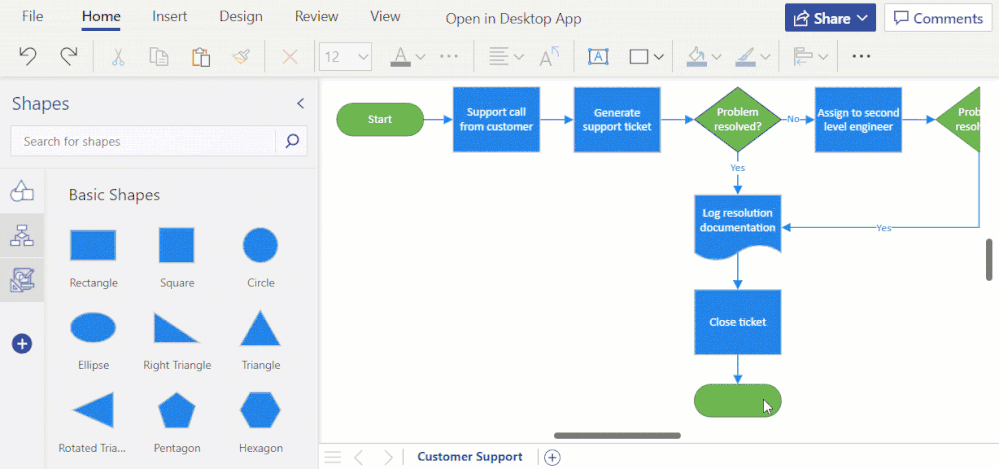
by Contributed | Feb 17, 2022 | Technology
This article is contributed. See the original author and article here.
During our Microsoft Ignite session last fall, we recapped some of the latest features in Visio for the web. In that session, we also announced several upcoming features and improvements that will help you create better looking diagrams faster and new tools to help you add some personalization. This blog post covers the details of those features, which are currently rolling out to Visio for the web users—including Visio in Microsoft 365, Visio Plan 1, and Visio Plan 2—unless otherwise noted.
New and improved diagramming tools in Visio for the web
Format Painter (currently rolling out): We are excited to introduce the Format Painter tool in Visio for the web. Using Format Painter, you can quickly copy the fill and formatting of one shape to a single shape or to multiple shapes in your diagram with a few clicks. Format Painter can be accessed from the Home tab or from the floating context menu, as you’ll read about soon, which appears when you right-click or select an object. Please note that copying the format of grouped shapes is not currently supported. Visit our support article to learn more about the Format Painter tool in Visio for the web.
 Animated demonstration of the Format Painter tool
Animated demonstration of the Format Painter tool
Shapes in the Document stencil (currently rolling out): Previously available only in the Visio desktop app, the Shapes in the Document stencil is rolling out to Visio Plan 2 subscribers in Visio for the web. With the Shapes in the Document stencil, you can now quickly access and use shapes that exist in your Visio file. The stencil will always be pinned to the shape panel—whether you start from a new blank drawing or a template. If starting new, you will need to add shapes to the canvas before they appear in the Shapes in the Document stencil.
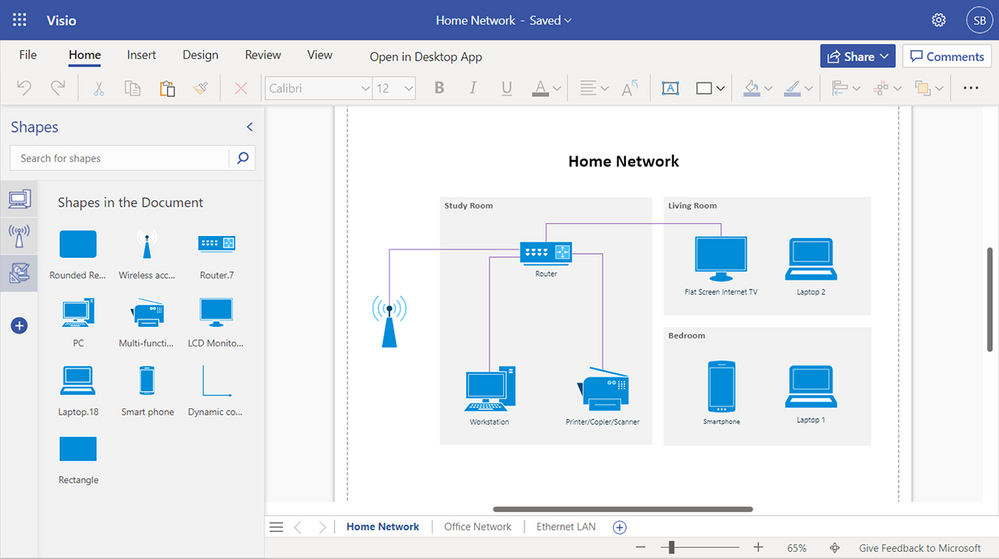 Example of the Shapes in the Document stencil within the Shapes panel
Example of the Shapes in the Document stencil within the Shapes panel
Enhanced floating context menus (currently rolling out): We are adding common user actions and formatting options in the floating context menus, so you can quickly access the necessary tools needed to complete your diagram faster. Simply right-click or select the appropriate object in your diagram and choose the desired action from the context menu. Newly added commands enable you to quickly rotate text, change the shape outline weight and style, edit connector lines, arrows, or points, make connectors curved, angled, or straight, and—speaking of Format Painter—apply the same formatting to multiple objects in your diagram.
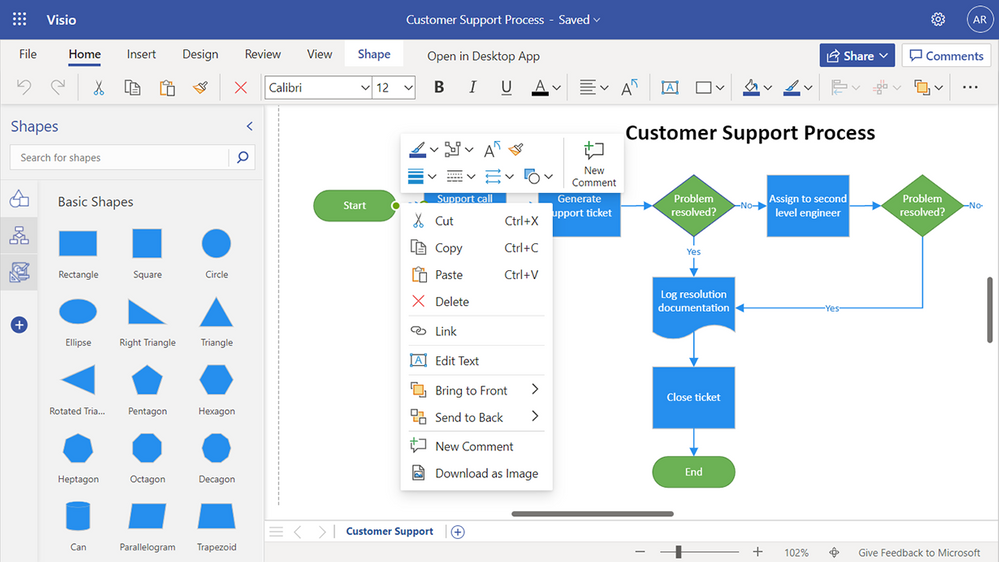 Example of user options available on the floating context menu, such as copy, paste, delete and more
Example of user options available on the floating context menu, such as copy, paste, delete and more
We’ve also enhanced this experience to support the press-and-hold method on a touchscreen device.
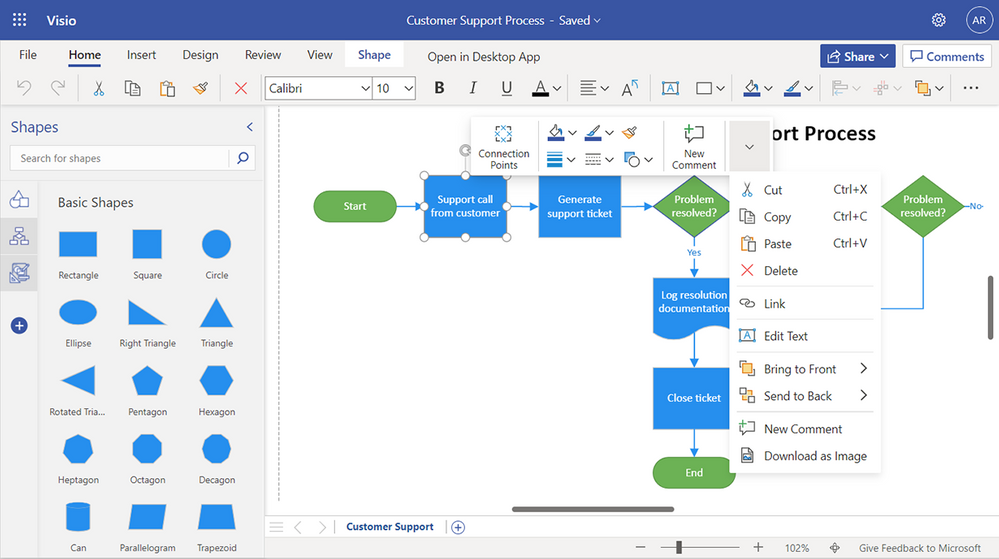 Example of user options on the floating context menu on a touchscreen device
Example of user options on the floating context menu on a touchscreen device
Snap experience improvements (currently rolling out): We’ve addressed one of your topmost concerns—aggressive snapping to objects in Visio for the web—and made the snap experience more user-friendly. This means when you draw, resize, or move a shape in your diagram, you will notice a smooth experience when snapping or aligning to other shapes or objects in your diagram. You can also turn the snap-to shapes capabilities on or off by selecting or deselecting the new Dynamic Grid checkbox available from the View tab in the ribbon.
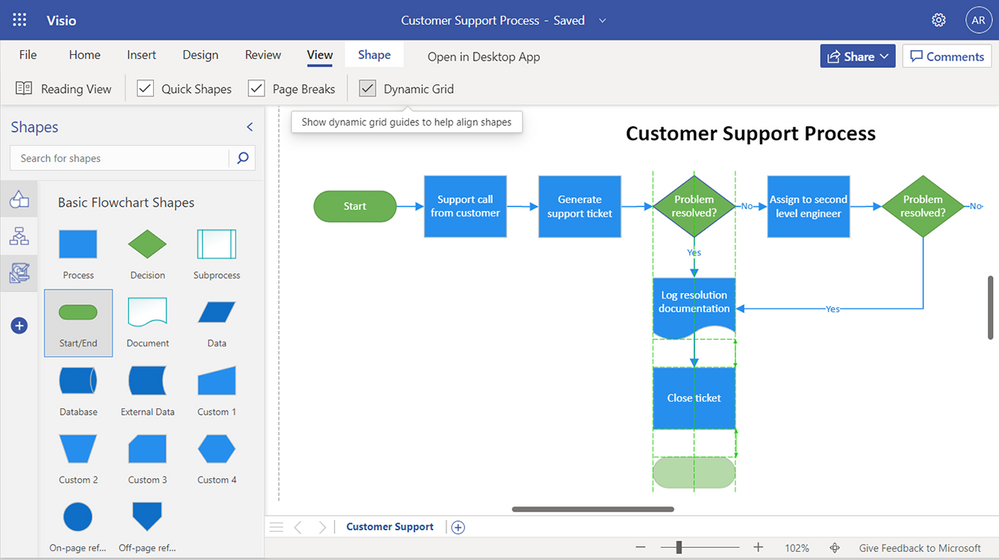 Example of snapping to objects by selecting the Dynamic Grid checkbox
Example of snapping to objects by selecting the Dynamic Grid checkbox
New customization tools in Visio for the web
Draw Shape tool (now available!): Visio for the web now supports drawing shapes, including rectangles, squares, lines, circles, and ellipses of the desired dimensions. The new Draw Shape tool can be accessed from both the Home tab and the Insert tab on the ribbon. To create a shape in your diagram from the Insert tab, go to the Draw Shape drop-down, select the shape you want, click anywhere on the canvas, and then drag the mouse pointer to draw the selected shape. Visit our support article to learn more about the Draw Shape tool in Visio for the web.
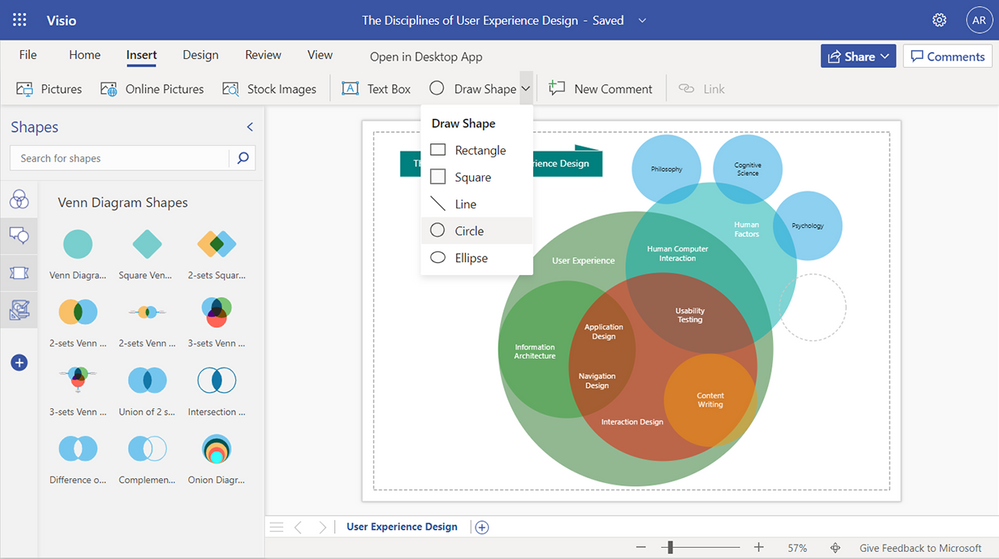 Example of the Draw Shape tool – Shapes include rectangles, squares, lines, circles, and ellipsesMore Colors, Recent Colors (now available!): Create flowcharts and diagrams that match your brand guidelines. Choose from a full spectrum of colors or customize the text color, shape fill, and shape outline for objects in your diagram with More Colors. If you know the HEX or RGB values, you can type them into the appropriate boxes in the Custom Colors panel. Then, quickly access recently used colors in your diagram with Recent Colors. More Colors and Recent Colors can be accessed from the Home tab, the Shape tab, or from the floating context menu, which appears when you right-click or select an object.
Example of the Draw Shape tool – Shapes include rectangles, squares, lines, circles, and ellipsesMore Colors, Recent Colors (now available!): Create flowcharts and diagrams that match your brand guidelines. Choose from a full spectrum of colors or customize the text color, shape fill, and shape outline for objects in your diagram with More Colors. If you know the HEX or RGB values, you can type them into the appropriate boxes in the Custom Colors panel. Then, quickly access recently used colors in your diagram with Recent Colors. More Colors and Recent Colors can be accessed from the Home tab, the Shape tab, or from the floating context menu, which appears when you right-click or select an object.
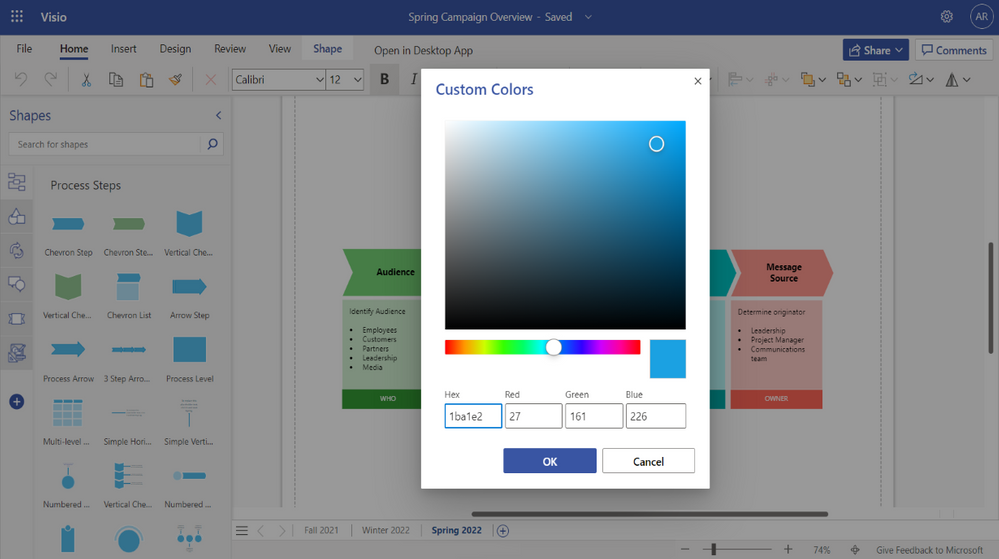 Example of the Custom Colors panel, including Hex and RGB values
Example of the Custom Colors panel, including Hex and RGB values
*Bonus announcement for desktop users of Office*
Modern landing page for Visio in the Office desktop app (now available!): We have recently added Visio’s modern landing page to the Office desktop app, providing users with a familiar and collaborative start experience similar to other Office apps, like Microsoft Word, Microsoft Excel, and Microsoft PowerPoint. Visio users will now get access to a powerful set of Office features, such as improved file discovery, better template categorization, and quick access to Visio files that have been recently edited, accessed, and reviewed by colleagues directly in the Office desktop app.
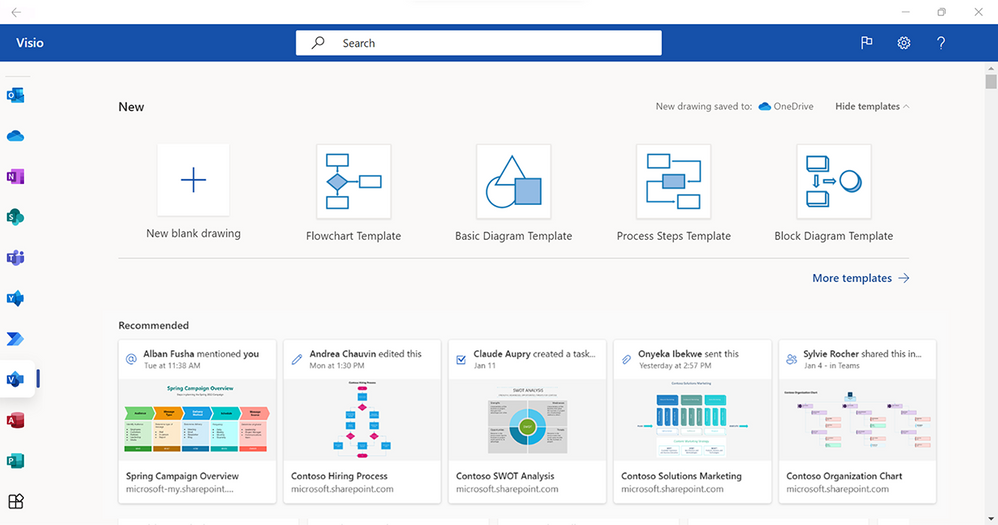 Example of the modern landing page in Visio in the Office desktop app – Showing template options and a Recommended section
Example of the modern landing page in Visio in the Office desktop app – Showing template options and a Recommended section
To try the new experience, search for and open the Office app on your Windows device. Click on the Visio icon in the side navigation bar or search for “Visio” in the Search box. This will launch the modern landing page for Visio in the Office environment where you can quickly create new diagrams, and access Visio files, including Recommended, Recently opened, Shared, and Favorites to quickly pick up where colleagues left off.
Give us your feedback! Please tell us what you think of the new diagramming and customization tools in the comments below or send feedback via the Visio Feedback portal. Follow us on Twitter and LinkedIn to stay informed with the latest updates for Visio.
Want to know what other Visio features have been released recently or what’s coming soon? Check out these Visio updates on the Microsoft 365 Roadmap to learn more!
Continue the conversation by joining us in the Microsoft 365 Tech Community! Whether you have product questions or just want to stay informed with the latest updates on new releases, tools, and blogs, Microsoft 365 Tech Community is your go-to resource to stay connected!
by Scott Muniz | Feb 17, 2022 | Security, Technology
This article is contributed. See the original author and article here.
The National Security Agency (NSA) has released a Cybersecurity Information (CSI) sheet with guidance on securing network infrastructure devices and credentials. Cisco devices are used globally to secure network infrastructure devices, including across the Department of Defense, National Security Systems, and the Defense Industrial Base. Credentials within Cisco configuration files could be at risk of compromise if strong password types are not used. The CSI reviews Cisco’s password type options, the difficulty to crack each password type, and its vulnerability severity and provides recommendations for use.
CISA encourages administrators to review NSA’s CSI: Cisco Password Types: Best Practices and consider the recommendations to secure sensitive credentials.




Recent Comments